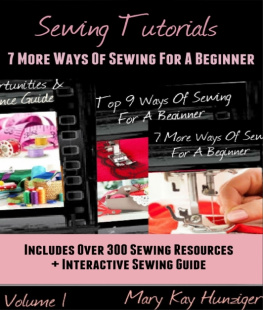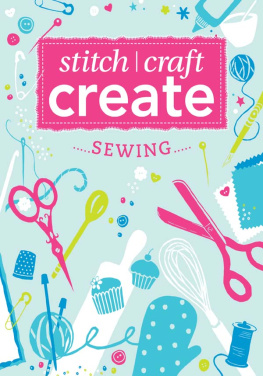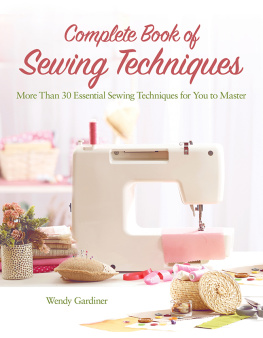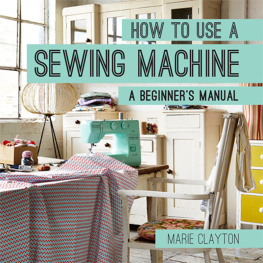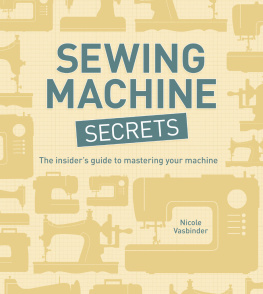Contents
The Big Sewing Book
Basics & Techniques
Sewing is fun, and trendy too! With needles, thread and a sewing machine, making individual garments is easy so let your own creativity run free!
Use this book as a basis and you will quickly learn to sew, or even refresh previous knowledge. Let yourself be guided from the first seam to the finished garment as detailed instructions and step-by-step photos will provide all the information you need including:
The right equipment: sewing machine, tools and accessories
A quick guide to fabrics
Getting the right measurements
Patterns and cutting out
Hand and machine stitches
Seams and hems
Edges and neatening
Collars, necklines, sleeves and waistbands
Darts, pleats, pockets and fastenings
Small alterations and repairs
Easy sewing projects for beginners
Naumann & Gbel Verlagsgesellschaft mbH
a subsidiary of VEMAG Verlags- und Medien Aktiengesellschaft
Emil-Hoffmann-Strae 1, 50996 Cologne, Germany
www.vemag-medien.de
Text and realisation: Eva-Maria Heller
Cover picture: Inge Ofenstein
Translation: Rae Walter in association with First Edition Translations Ltd, Cambridge, UK
Overall production: Naumann & Gbel Verlagsgesellschaft mbH
All rights reserved
ISBN 978-3-8155-7660-1
Contents
The new love of sewing
Many people have already discovered the love of sewing for themselves, as well as the fun of experimenting and discovering their own creative streak. The interaction of needle, thread and sewing machine is all the rage. It requires not just basic knowledge and a certain amount of skill but most of all the desire to create something individual. Finally, when the work is finished, you will enjoy a great feeling of having completed something that is unique and unmistakably yours.
This sewing course is a wide-ranging programme for beginners and those who want to refresh their knowledge. Easy to understand and clearly explained in words and pictures, the book presents the most important techniques, as well as valuable tips on everything to do with sewing. There are also projects for beginners that will guarantee success and encourage the desire to experiment.
Anyone who wants to start off with something really fashionable should at first choose proprietary printed patterns that are straightforward to follow. Check the degree of difficulty indicated levels 1 and 2 are suitable for beginners. Then all you need is a beautiful fabric, matching thread, a working sewing machine and any necessary accessories. After that nothing will stand in the way of your success. What is more, sewing is not just something to do at home. More and more women of all ages are now meeting up in sewing groups. Maybe there is a sewing group or a sewing caf in your town. If not, ask your friends if they fancy getting together to discover the new love of sewing.
Have fun, and of course we wish you every possible success.
The Editorial Team
The sewing machine
The first sewing machine was invented round the end of the 18th century and was revolutionary at the time. Luckily modern sewing machines have very little in common with the technology of that period. Todays machines make sewing a real pleasure.

Nowadays the most widely available sewing machines are a combination of base plate and free arm. They are sold with carrying cases and need a relatively low work table as the base plate makes the work surface higher. The free arm makes it possible to sew parts that are awkward to get at, such as trouser legs and sleeves. Slightly less common are flat-bed machines that are built into sewing tables or cupboards. The machines are driven by electric motors, operated by a foot pedal. The foot pedal is also used to regulate the sewing speed.
If you are contemplating buying a new machine, it should definitely be equipped with various general-purpose stitches, such as straight stitch, zigzag, hem stitch, overlock stitch, various stretch stitches, a few decorative stitches and fully automatic buttonhole stitches. If your machine meets these requirements you can get started right away.
Parts and their functions
1 Use this dial to select a variable stitch length from 0 to 5 mm.
2 Stitch selection dial.
3 Turning the hand wheel by hand enables you to sew single stitches.
4 This is where the lower-thread bobbin is wound with the desired thread.
5 Here you can change the stitch width e.g. for zigzag stitch.
6 The automatic needle threader makes it easy to insert the thread into the eye of the needle.
7 The extension table keeps sewing accessories handy. The bobbin is inserted behind it.
8 Upper thread tension dial.
9 Reverse feed button. As long as this is pressed in, the machine sews the selected stitch in the reverse direction for securing the beginnings and ends of lines of stitching.
Threading the upper thread
a Place the spool of thread on the pin.
b Draw the thread towards the front through the snap-in thread guide.
c Draw the thread down from right to left through the thread tensioner.
d Draw the thread from right to left through the thread guide.
e Use the needle threader to insert the thread through the eye of the needle.
To wind the bobbin, place the bobbin on the pin. Draw the thread from the spool to the bobbin, wind it round the bobbin a few times and press the button to the left of the bobbin. Now press the foot pedal and the thread will wind automatically onto the bobbin. Place the bobbin in the bobbin case and click this into the body of the machine behind the extension table.
Upper and lower threads
Correctly adjusting the tension for the upper and lower threads is important in order to get perfect-looking seams. Ideally the point where the upper and lower threads interlock should lie exactly in between the layers of fabric being sewn.

If the upper thread tension is too tight, the upper thread will lie flat on the surface and loops will form on top of the fabric.

If the upper thread tension is too loose, the lower thread will be stretched taut under the material and the upper thread will form loops under the work.

Accessories
When buying a sewing machine, you will get various types of presser foot as basic equipment. There are additional presser feet available that make particular sewing techniques easier and/or offer more opportunities for creativity.
Basic equipment
As a rule, many accessories are supplied with a sewing machine. They are specially designed to fit the machine and are constantly needed, some of them for maintenance.
For example, a small screwdriver is used to adjust the tension on the bobbin case, while a fine brush with artificial hair is used to remove fluff from the machine. Sewing machine oil is needed for servicing some machines, and this will be found in a small bottle. In the accessory box you will also find spare needles for the machine and a few empty bobbins.


